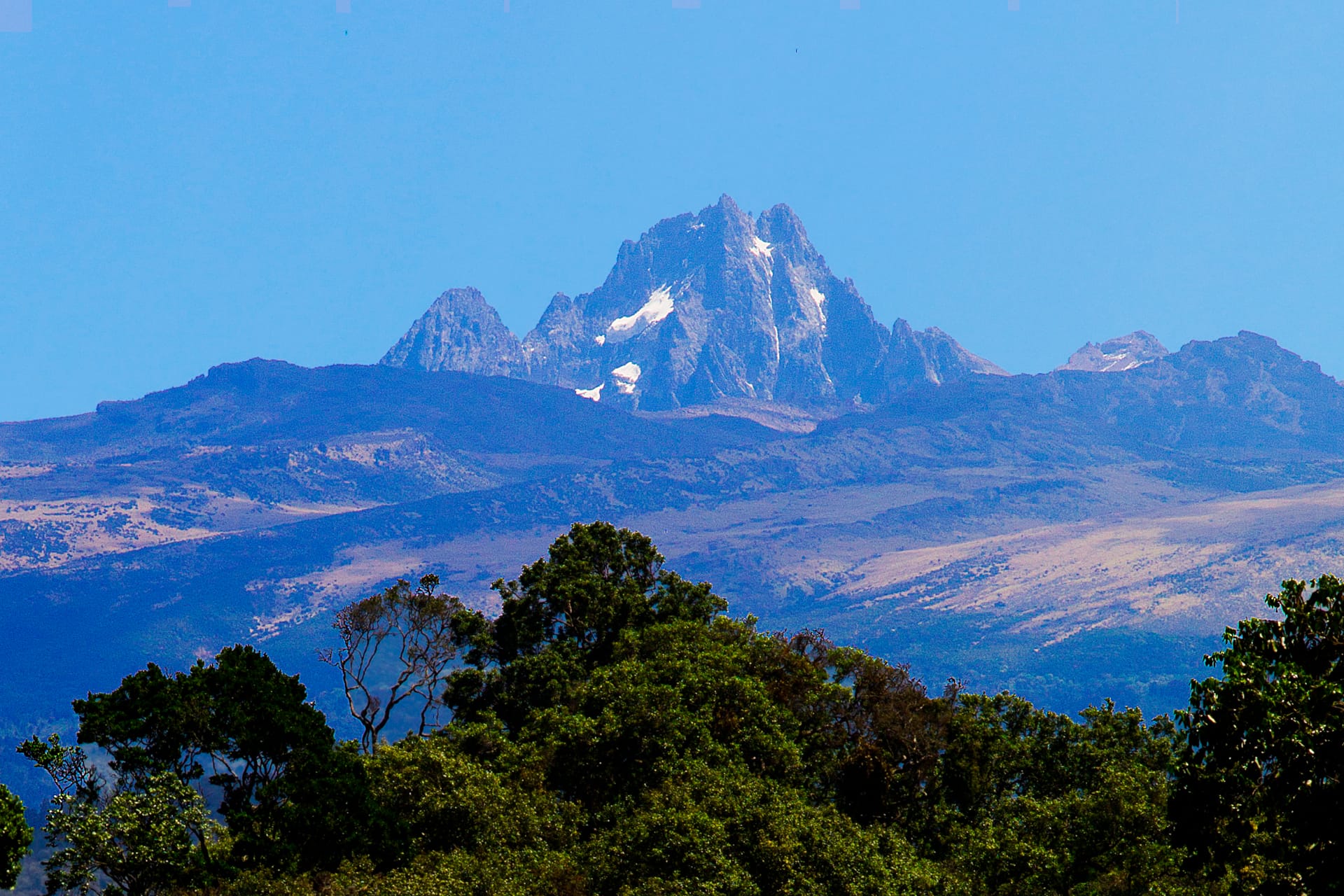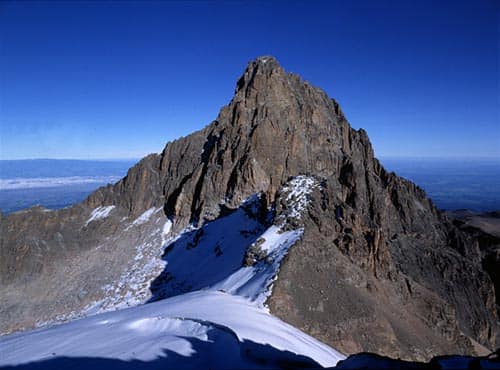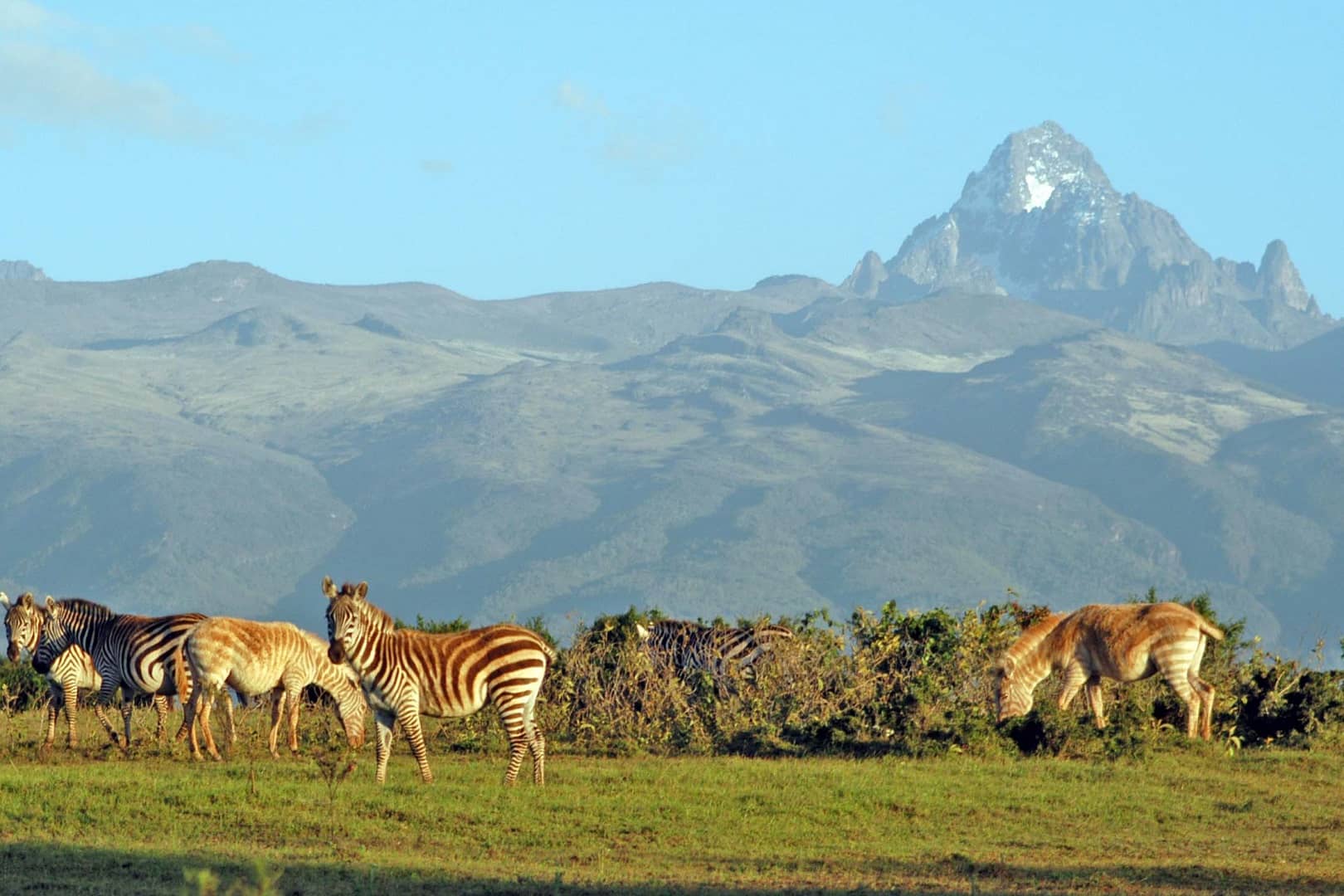Kenya Destinations
The majority of Kenya’s large population of wildlife dwells outside of the nation’s various national parks and game reserves. For example, along the Nairobi-Nakuru highway, close to populated areas and metropolitan centers, baboons and zebras can be seen. Because of this, there have been conflicts between people and animals, which have occasionally been handled by moving the animals to places with less people.
Each region’s vegetation and the variety and distribution of its fauna are closely related. Elephants and rhinoceroses are the two largest creatures found in the highland rainforests, but both species have suffered greatly from poaching and destruction. Galagos (bush baby), colobus monkeys, and bushbuck are also common.
Mountain Adventure
Mount Kenya National Park
Rise above the mundane and travel to the Mt. Kenya National Park, East Africa’s crown treasure. The sky is pierced by majestic peaks, revealing an amazing and exciting world. Explore rocky routes, take in the refreshing mountain air, and lose yourself in nature. Navigate through lush woods and alpine meadows to meet the iconic wildlife, which includes majestic elephants and elusive leopards. Be in awe of glaciers that whisper tales of ancient beauty, peaceful lakes, and flowing waterfalls. While on your Kenya Safari Tour, Mt. Kenya National Park begs you to experience the extraordinary with every step.



Safari Adventure
Maasai Mara National Park
The Maasai Mara National Reserve, one of the most famous safari locations in the world, enchants visitors with its boundless grassy plains, scattered acacia trees, and teaming with wildlife. Watch as millions of wildebeest, zebras, and gazelles traverse crocodile-infested rivers in pursuit of greener pastures during the magnificent Great Migration. Discover the Big Five while exploring the many landscapes, including riverine woods and rolling hills. Let’s get ready for a once-in-a-lifetime Kenya Safari excursion in the Maasai Mara National Reserve.


Excursions
Nairobi National Park
The Nairobi National Park is only a short drive from Nairobi’s downtown. A diversity of wildlife, including the endangered black rhino, lions, leopards, cheetahs, hyenas, buffaloes, giraffes, and rich birdlife with over 400 species reported, can be seen amid wide-open grass plains with city skyscrapers in the background and scattered acacia thicket. Picnic areas, three campsites, and hiking paths are available for guests to enjoy.



Safari
Samburu National Park
The Samburu National Reserve is located in Kenya’s Rift Valley Province in the southeast portion of the Samburu District. It is divided from the Buffalo Springs National Reserve to the south by the Ewaso Nyiro River. The reserve has a 165 km2 area and is about 345 km from Nairobi. The reserve is rich in wildlife and is renowned for having large populations of endangered northern specialized species such the Grevy Zebra, Somali Ostrich, Reticulated Giraffe, Gerenuk, and the Beisa Oryx (also known as Samburu Special). There are at least 900 elephants in the reserve, which is also well-liked.


Wildlife
Tsavo East/West National Parks
One of the most moving sights in Africa is the sight of dust-red elephant wallowing, rolling, and splashing each other with the midnight blue waters of the palm-fringed Galana River. This makes for an excursion unlike any other in the Tsavo East, together with the 300 kilometer-long Yatta Plateau, the largest lava flow in the world. The park is the largest protected area in Kenya and is home to many large mammals, including enormous herds of red elephants, rhinos, buffalo, lions, and leopards as well as pods of hippopotamuses, crocodiles, waterbucks, lesser kudus, and gerenuks. Tsavo West is a stunning, untamed wilderness, from the sight of fifty million gallons of crystal pure water spilling out of the under parched lava rock that is the Mzima Springs to the Shetani lava flows. The broad grasslands, scrublands, and Acacia forests, as well as belts of riverine vegetation and rocky ridges like Poacher’s Lookout, which offers views of the teeming herds in the plains below, make up the savannah habitat.




Range Adventure
Arberdare National Park
A sight to behold is the rise and fall of the misty valleys, hills, and mountains of the magnificent Aberdare ranges, which span Nyeri and Nyandarua counties. The large park’s open moorlands and dense woodlands, along with the deep richness of clean, crisp air, make it ideal for a getaway from life in pursuit of relaxation, quiet, and solitude. One of the delights of a trip to this destination is the magnificent alpine environment. Aberdare is a paradise for animals. Travelers may expect to witness the African golden cat, lion, leopard, African wild dog, hyena, and jackal among other predator species. Eland, bushbuck, buffalo, reedbuck, giant forest hog, warthog, and the critically endangered black rhinoceros are a few of the other well-known species. In Kenya’s central highlands, close to the town of Nyeri, is where you’ll find the Aberdare National Park. With peaks that rise to a maximum of 13,000 feet, it is a rough and hilly region. The park is well-known for the variety of species it supports, which includes elephants, buffalo, the uncommon bongo antelope, and enormous forest pigs. Additionally, it features several bird species and breathtaking waterfalls. Visitors may learn about the culture and way of life of the Kikuyu people, one of the major ethnic groups in Kenya, who also live in the park


Wildlife
Amboseli National Park
One of Kenya’s most well-known parks is the Amboseli National Parks, which is crowned by Mount Kilimanjaro, Africa’s highest peak. One of the best spots in Africa to see big herds of elephants up close is Amboseli, which is a Maasai word that means “salty dust.” Here, nature enthusiasts can discover five distinct habitats, including the dried-up lake bed of Lake Amboseli, wetlands with sulfur springs, savannah, and woods. In addition to enhancing the beauty, Mount Kilimanjaro has had a more profound impact on the environment and animals of Amboseli.Freshwater springs in Amboseli are continuously produced by the mountain’s glaciers melting snow, which runs off the mountain’s slopes and sinks into the earth.


Conservation
Ol Pejeta Conservancy
Two of the few remaining northern white rhinos in the world may be found at Ol Pejeta, the largest black rhino sanctuary in East Africa. In a refuge created to rehabilitate animals rescued from the illegal market, it is the only spot in Kenya where you may observe chimpanzees. It still runs a highly effective livestock program despite having some of the highest predator populations in all of Kenya. In order to guarantee that animal protection leads to greater infrastructure, healthcare, and educational opportunities for the following generation of wildlife guardians, Ol Pejeta also works to serve the local communities that surround its borders. All of the Big Five are found in Ol Pejeta Conservancy, one of the most important sanctuaries on the Laikipia Plateau. The Ol Pejeta Conservancy provides fantastic chances to see animals. The Big Five are all present, and both black and white rhino sightings are frequent. Apart from the big cats, there is a potential of spotting wild canines, and it has some of the greatest predator populations in the area. Here, there are also endangered populations of the Grevy’s zebra, Jackson’s hartebeest, and Beisa oryx.


Conservation
Lewa Conservancy
The severely endangered Grevy’s zebra, critically endangered black rhinos, elephants, lions, giraffes, wild dogs, and other recognizable Kenyan wildlife species all find sanctuary in Lewa. Additionally, the Conservancy is home to over 450 different bird species. Lewa imagines a time when wildlife is valued, protected, and advantageous to all Kenyans. Communities’ ability to generate daily income in ways that are compatible with thriving wildlife habitats is essential to this future. As a result, Lewa makes significant investments in its neighbors’ quality of life through programs in water, microenterprise, youth development, and more. Lewa has merged cutting-edge monitoring technology with world-class anti-poaching measures with the involvement of the local communities as vital conservation partners. Nine tourism establishments that provide a singular, individualized safari experience with a conservation focus are also located on Lewa and Borana.


Lake Adventure
Lake Turkana
The most saline of Africa’s large lakes, Turkana is an outstanding laboratory for the study of plant and animal communities. The three National Parks serve as a stopover for migrant waterfowl and are major breeding grounds for the Nile crocodile, hippopotamus and a variety of venomous snakes. The Koobi Fora deposits, rich in mammalian, molluscan and other fossil remains, have contributed more to the understanding of paleo-environments than any other site on the continent. Lake Turkana National Parks are constituted of Sibiloi National Park, the South Island and the Central Island National Parks, covering a total area of 161,485 hectares located within the Lake Turkana basin whose total surface area is 7 million ha.


Lake Adventure
Lake Baringo
Lake Baringo, lake in west-central Kenya. It is situated 3,200 feet (975 m) above sea level in the Great Rift Valley, east of the Kamasia (Ilkamasya) Hills. The lake has an area of 50 square miles (129 square km), is 11 miles (18 km) long and 5 miles (8 km) wide, and has an average depth of 17 feet (5 m). A freshwater lake with no visible outlet, its waters seep into lavas at its northern end, where a rocky shore contrasts with the alluvial flat on its southern border. A great variety of birds inhabit the lake, which is also home to hippopotamuses and crocodiles.


